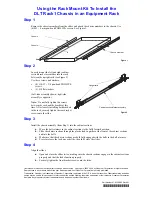
Creating an Interface
Use the following example to create a new interface in a context:
configure
context
name
interface name
{ ip | ipv6 } address address subnetmask
[
secondary
]
end
Notes:
•
Optional:
Add the
loopback
keyword option to the
interface name
command, to set the interface type
as "loopback" which is always UP and not bound to any physical port.
•
Optional:
Add the
secondary
keyword to the
{ ip | ipv6 } address
command, to assign multiple IP
addresses to the interface. IP addresses can be entered using IPv4 dotted-decimal or IPv6
colon-separated-hexadecimal notation.
•
Optional:
In the interface config mode, add the
port-switch-on-L3-fail address
command, to configure
the interface for switchover to the port on the redundant line card if connectivity to a specified IP address
is lost. This IP address can be entered using IPv4 dotted-decimal or IPv6 colon-separated-hexadecimal
notation.
Configuring a Port and Binding It to an Interface
Use the following example configuration to configure and assign a port to an interface:
configure
port ethernet slot#/port#
description description
no shutdown
bind interface interface_name context_name
end
Notes:
•
Optional:
In the Ethernet Port configuration mode, add the preferred
slot slot#
command if you want
to specify a port preference.
•
Binding associates the port and all of its settings to the named interface.
Configuring a Static Route for an Interface
Use the following example to configure a static route for an interface:
configure
context name
{ ip | ipv6 } route ip_address netmask next-hop gw_address interface_name
end
Notes:
ASR 5500 System Administration Guide, StarOS Release 21.5
71
System Interfaces and Ports
Creating an Interface


































